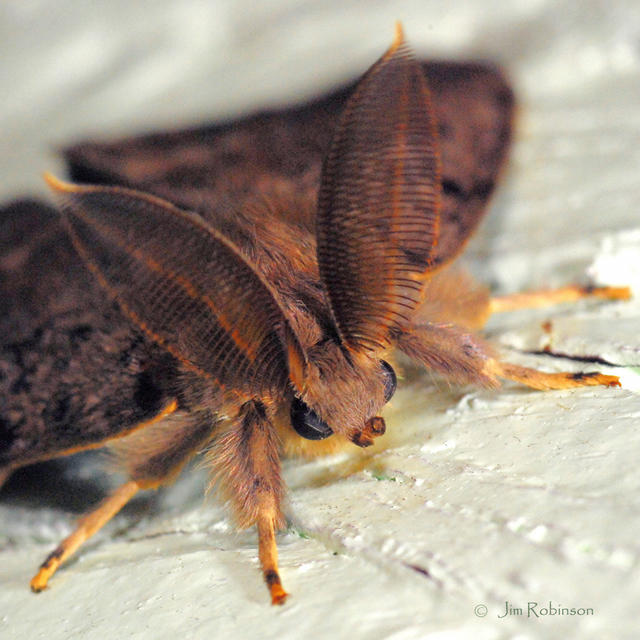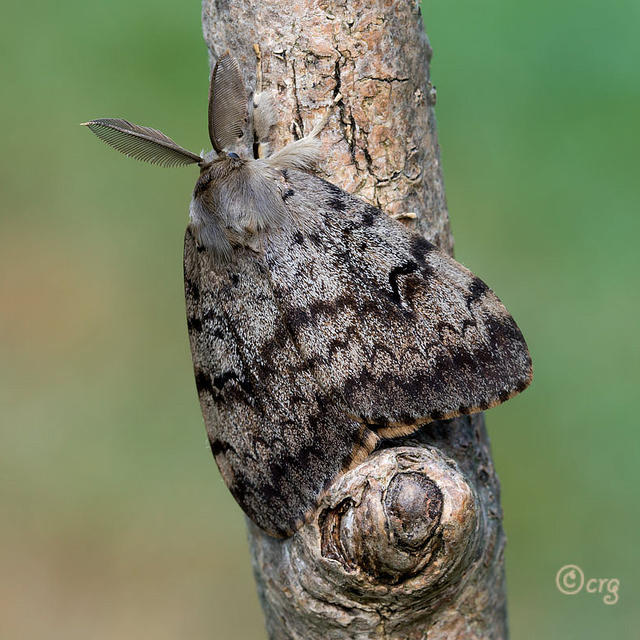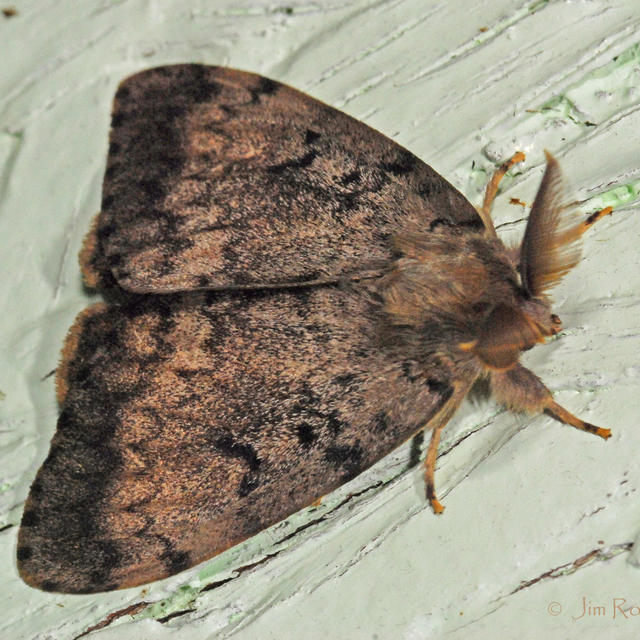Lymantria dispar (Linnaeus, 1758)
Family: Erebidae
Subfamily: Lymantriinae
Identification: Sexually dimorphic: female much larger and lighter in color. Forewing brown with yellowish overlay in male. Hindwing yellowish to reddish brown. Reniform spot consists of three black spots (usually merged) in both sexes; black orbicular dot also present. Wings whitish in female, with deeply scalloped gray lines and black spots. Terminal line a series of black dots on forewing and hindwing.
Wing Span: 3-4 cm in males; 5.6-6.7 cm in females.
Life History: Larvae can defoliate large tracts of forests in peak years. In woods where larvae are numerous, you can actually hear them feeding.
Flight:
Caterpillar Hosts: Oaks are preferred. Also alder, apple, basswood, birches, box elder, hawthorn, hazelnut, larch, mountain-ash, poplars, rose bushes, sumac, willows, and witch-hazel.
Adult Food:
Habitat: Forests.
Range: Deliberately introduced from Europe at Medford, Massachusetts in 1868 or 1869 by Leopold Trouvelot, who hoped to raise this moth for silk production. Now, established from Nova Scotia to North Carolina and Florida, west to Michigan, Illinois, and Missouri. Range is expanding.
Conservation:
NCGR:
Management Needs:
Taxonomy Notes: Formerly referred to by a derogatory common name of "gypsy moth," which was removed from the Entomological Society of America's Common Names of Insects and Related Organisms List in July 2021.
BAMONA Shop
Please donate!
We depend on donations to keep Butterflies and Moths of North America freely available. We want to express our gratitude to all who showed their support by making a contribution this year. You can donate to support this project at any time.
Advertise with us!
Do you have a product or service that you think would interest BAMONA users? If you would like to advertise on this website, contact us by email, or use the contact form and select the "Advertising" category.
Verified Sightings
Displaying 1 - 24 of 620 verified sightings

Observation date: Aug 24, 2025
Submitted by: drifter423
Region: New Brunswick, Canada
Verified by: Sue Gregoire
Verified date: Aug 26, 2025

Observation date: Aug 04, 2025
Submitted by: Moth5577
Region: Broome County, New York, United States
Verified by: Sue Gregoire
Verified date: Aug 23, 2025

Observation date: Sep 16, 2020
Submitted by: kkamas
Region: Chemung County, New York, United States
Verified by: Sue Gregoire
Verified date: Aug 16, 2025

Observation date: Aug 01, 2025
Submitted by: LittleWoodSatyr
Region: Defiance County, Ohio, United States
Verified by: rogerdowner
Verified date: Aug 12, 2025

Observation date: Jun 21, 2025
Submitted by: Shane Miller
Region: Beaver County, Pennsylvania, United States
Verified by: curtis.lehman
Verified date: Jul 29, 2025

Observation date: Oct 24, 2023
Submitted by: Susan McSwain
Region: Nelson County, Virginia, United States
Verified by: jwileyrains
Verified date: Jul 29, 2025

Observation date: Jul 26, 2025
Submitted by: David Trently
Region: Lackawanna County, Pennsylvania, United States
Verified by: curtis.lehman
Verified date: Jul 28, 2025

Observation date: Jul 19, 2025
Submitted by: rmery
Region: Luzerne County, Pennsylvania, United States
Verified by: curtis.lehman
Verified date: Jul 25, 2025

Observation date: Jul 18, 2025
Submitted by: Shane Miller
Region: Washington County, Pennsylvania, United States
Verified by: curtis.lehman
Verified date: Jul 23, 2025

Observation date: Jul 18, 2025
Submitted by: Shane Miller
Region: Washington County, Pennsylvania, United States
Verified by: curtis.lehman
Verified date: Jul 23, 2025

Observation date: Jul 21, 2025
Submitted by: rapids
Region: Ontario, Canada
Verified by: curtis.lehman
Verified date: Jul 22, 2025

Observation date: Jul 19, 2025
Submitted by: Shane Miller
Region: Washington County, Pennsylvania, United States
Verified by: curtis.lehman
Verified date: Jul 22, 2025

Observation date: Jul 22, 2024
Submitted by: commentator
Region: Ontario, Canada
Verified by: curtis.lehman
Verified date: Jul 22, 2025

Observation date: Jul 21, 2025
Submitted by: rapids
Region: Ontario, Canada
Verified by: curtis.lehman
Verified date: Jul 21, 2025

Observation date: Jun 15, 2024
Submitted by: Daniel Morton
Region: Sussex County, New Jersey, United States
Verified by: curtis.lehman
Verified date: Jul 12, 2025

Observation date: Jun 26, 2025
Submitted by: vvryabyy
Region: Dauphin County, Pennsylvania, United States
Verified by: curtis.lehman
Verified date: Jun 28, 2025

Observation date: Jun 22, 2025
Submitted by: Steven Wilson
Region: Blair County, Pennsylvania, United States
Verified by: curtis.lehman
Verified date: Jun 22, 2025

Observation date: Jun 02, 2025
Submitted by: a.d.levine
Region: Orange County, New York, United States
Verified by: jmgesell
Verified date: Jun 03, 2025

Observation date: Mar 14, 2025
Submitted by: Amcenhill
Region: Dutchess County, New York, United States
Verified by: BarbSendelbach
Verified date: Mar 24, 2025

Observation date: Jun 30, 2016
Submitted by: Wade Wander
Region: Sussex County, New Jersey, United States
Verified by: curtis.lehman
Verified date: Jan 18, 2025

Observation date: Aug 11, 2024
Submitted by: Jacksenzig
Region: Taylor County, Wisconsin, United States
Verified by: Ilona L.
Verified date: Sep 01, 2024

Observation date: Jun 25, 2024
Submitted by: Victoire Batiste
Region: Dutchess County, New York, United States
Verified by: Sue Gregoire
Verified date: Aug 08, 2024

Observation date: Jun 25, 2024
Submitted by: Victoire Batiste
Region: Dutchess County, New York, United States
Verified by: jwileyrains
Verified date: Aug 07, 2024

Observation date: Jul 31, 2024
Submitted by: RStankiewicz
Region: Ontario, Canada
Verified by: rogerdowner
Verified date: Aug 01, 2024
- 1 of 26
- next ›









